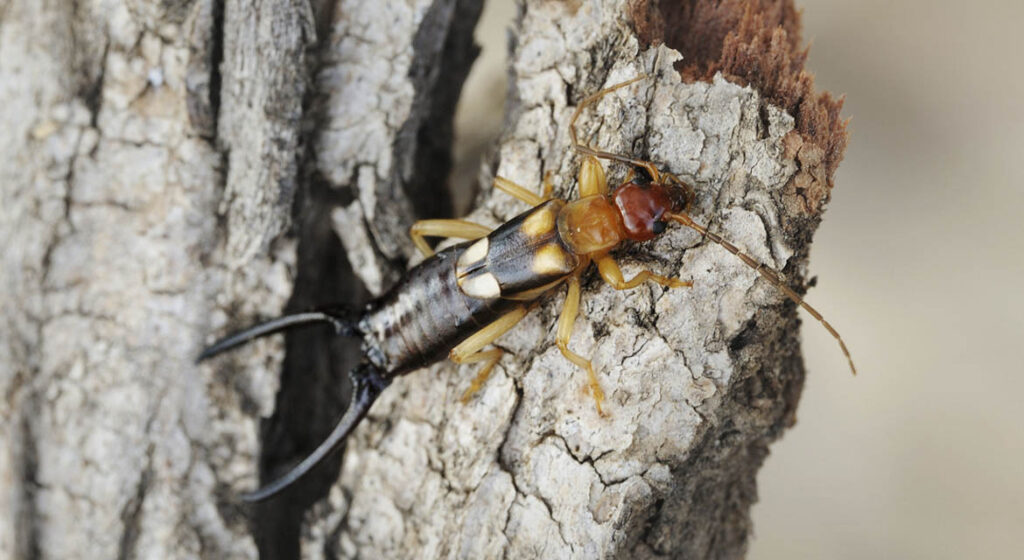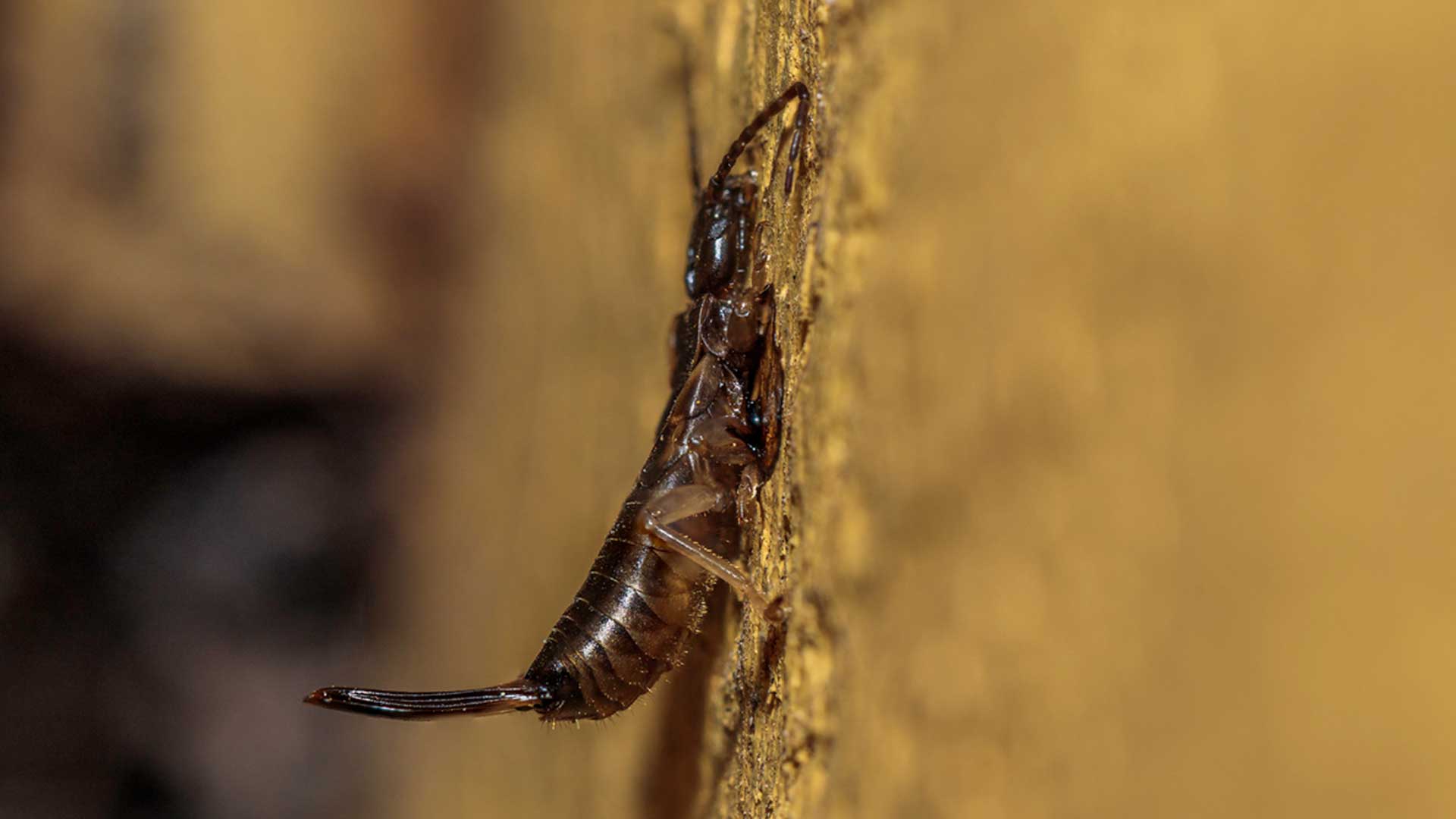
Earwig Infestation: Signs, Causes, and Prevention Guide
Have you ever noticed small insects with pincers on the end of their bodies lurking around your garden or home? They might be earwigs — a common pest found in all parts of the world. Here are three key points regarding an earwig infestation:
- Signs of earwig infestation include the presence of live earwigs, plant damage, and shed exoskeletons.
- Earwig infestations can be caused by moisture and darkness in and around the home, outdoor habitats, and entry points.
- To prevent earwig infestations, it is important to reduce moisture, manage outdoor areas, and seal entry points to your home.
Identifying Earwigs and Their Infestations
Earwigs are pesky insects that can infest gardens and homes and cause issues with your plants and property. If you suspect an earwig infestation, it’s important to identify the signs early on so that you can take action before the problem gets out of hand.
What Are Earwigs?
Earwigs are small insects that have long bodies with two pairs of wings — although it’s rare to see a flying earwig. These bugs are typically brown or black in color and have pincers at the end of their abdomen. These pincers may look intimidating, but they are rarely strong enough to break skin and aren’t considered harmful to humans.
Where Do Earwigs Live?
Earwigs prefer moist soil and wood, making these areas more susceptible to infestation. They are commonly found living under rocks, logs, mulch piles, and other debris in gardens. They may also make their way into homes through cracks or gaps in doors and windows.
Signs of an Earwig Infestation
One of the most common signs of an earwig infestation is damage to plant leaves. Earwigs feed on vegetation, so if you notice holes in your garden plants or indoor foliage, it could indicate that earwigs are present. You may also find wilted leaves or small tunnels in the soil around your plants where the earwig insects have burrowed.
To search for signs of earwig infestations, be sure to also inspect the exterior of your home for any cracks or gaps where earwigs may be entering. You can also set up traps to catch earwigs and confirm their presence. Since earwigs love moisture, a good tip is to place a damp newspaper or cardboard in areas where you suspect earwigs are present, and check it the next day for any trapped insects.

Truly Nolen GUARANTEE
If you’re not completely satisfied, you’ll get a full refund on your most recent service with our 100% money back guarantee.

$50 Off Year Round Pest Control
Truly Nolen is a family-owned company with 85 years of experience providing the best pest control. If you’re not completely satisfied, you’ll get a full refund on your most recent service with our 100% money back guarantee.
Common Causes of Earwig Problems
Whether you already have an earwig infestation or you’re hoping to prevent their arrival, it can be helpful to know what attracts these pests. There are several factors that can contribute to an earwig problem, including moisture, light, overgrown vegetation, warm climates, and poor sanitation practices.
Moisture Attracts Earwigs and Can Lead to an Infestation
Earwigs thrive in damp environments and are often found in areas with high humidity levels. This is why they are commonly seen in bathrooms, kitchens, and other areas of the home where moisture is present. If you have a leaky faucet or pipes, this can create the perfect environment for earwigs to thrive.
Earwigs Are Attracted To Light and May Enter Homes Through Cracks and Crevices
Like many insects, earwigs are attracted to light. This means they may gather around outdoor lights near your home or even try to get closer to some of your indoor lights. Since earwigs are relatively small insects, they can easily enter your home through cracks and crevices around windows and doors. Once inside, they will seek out dark hiding places during the day and come out at night in search of food. Installing screens on your windows and using yellow bug lights outside instead of bright white lights may help keep earwigs at bay.
Overgrown Vegetation Around the Home Can Provide a Habitat for Earwigs
Earwigs love hiding in dark spaces, such as under rocks or piles of leaves. Overgrown vegetation around your home can provide plenty of hiding spots for these pests. If you have a garden or landscaping around your house, it’s important to keep it well-maintained and trimmed back to prevent earwigs from taking up residence.
Earwigs Are More Common in Areas With Warm Climates
Earwigs prefer temperatures between 70 – 80 degrees Fahrenheit, so they are most common in warmer climates. This means that if you live somewhere hot and humid, you may be more likely to experience an earwig infestation.
Poor Sanitation Practices Can Lead to an Increase in Earwig Populations
Earwigs are attracted to decaying organic matter, such as dead leaves or plant debris. Earwig nymphs often emerge from their nests in late spring and can be active through the fall, so raking your leaves and trimming back organic waste can be crucial to prevent an infestation. Other poor sanitation practices around your home, like unsealed garbage cans and improper disposal of food waste, can also lead to an increase in the number of earwigs present.
How To Get Rid of Earwigs in the House and Yard
If you already have an earwig infestation, you probably want to know how to get rid of them. Fortunately, you have several options for dealing with this common pest.
Hire an Exterminator or Pest Control Company for Severe Infestations
If you have a severe earwig bug infestation in your home or yard, it may be best to hire an exterminator or pest control company. These professionals have the expertise and equipment needed to effectively eliminate the problem. They will assess the extent of the infestation and recommend the best course of action.
When choosing an exterminator or pest control company, make sure they are licensed and insured. Ask for referrals from friends and family, read online reviews, and check their credentials before hiring them.
Use Dish Soap and Water To Create a Trap for Earwigs in the Bathroom
One way to eliminate earwigs in your bathroom is by creating a trap using dish soap and water. Mix equal parts dish soap and water in a shallow container like a jar lid or pie plate. Place the container near areas where you have seen earwig insects, such as around sinks or showers.
The dish soap acts as a surfactant that reduces surface tension on the water, causing earwigs to sink instead of float on top of it. Once they fall into the soapy water trap, they won’t be able to climb out because their legs will slip on the soapy surface. Be sure to empty your earwig traps regularly to avoid any significant buildup.
Apply Alcohol To Kill Earwigs on Contact in the Garden or Outdoors
If you’re dealing with an earwig infestation outdoors, alcohol can be an effective solution. Fill a spray bottle with rubbing alcohol and spray it directly on any earwigs you see. The alcohol will kill them on contact.
Be careful not to spray the alcohol on any plants, flowers, or helpful pollinators, as it can harm them. Also, avoid spraying near open flames or sources of heat, as alcohol is flammable.
Treat Potted Plants With Soil That Is Free of Plant Material To Prevent Earwig Infestations
Earwigs are attracted to moist environments and plant materials. To prevent earwig infestations in your potted plants, use soil that is free of large bits of compost, dead leaves, or other plant material. This will reduce the likelihood of earwigs finding a suitable environment to lay their eggs and thrive.
If you already have an earwig infestation in your potted plants, remove the affected soil and replace it with fresh soil that is free of plant material. You can also add diatomaceous earth to the top layer of soil as a natural way to control earwigs and deter them from laying eggs.

$50 Off Year Round Pest Control
Truly Nolen is a family-owned company with 85 years of experience providing the best pest control. If you’re not completely satisfied, you’ll get a full refund on your most recent service with our 100% money back guarantee.
Tips for Preventing Future Earwig Infestations
Keep Your Home and Garden Clean and Free of Debris
One of the most effective ways to prevent earwig infestations is by removing debris from your home and garden. Earwigs are attracted to dark, damp places where they can hide and breed. By removing piles of leaves, woodpiles, and other debris from your yard, you’ll eliminate potential hiding spots for these pests. Indoors, make sure to vacuum regularly under furniture, in corners, and behind appliances where earwigs may be lurking.
Use a Dehumidifier To Reduce Moisture Levels in Your Home
Since earwigs are also attracted to moisture, it’s important to keep your home as dry as possible. Using a dehumidifier can help reduce humidity levels indoors, making it less appealing for earwigs to take up residence. Make sure to fix any leaks or plumbing issues that could cause excess moisture buildup in your home.
Seal Any Cracks or Gaps in Your Home’s Foundation and Walls
To prevent earwigs from getting inside your home, it’s important to reduce their points of entry. Be sure to seal any openings in the foundation or walls with caulk or weatherstripping. This will not only keep out earwigs but also other pests like ants and centipedes.
Apply a Natural Oil Around the Perimeter of Your Home
Certain natural oils like neem oil or tea tree oil have been shown to repel earwigs when applied around the perimeter of your home. Simply mix a few drops of oil with water in a spray bottle and apply it along the baseboards of your home’s interior walls as well as outside around window sills and door frames.
Use Sticky Traps or Diatomaceous Earth
If you already have earwigs in the garden, using sticky traps or diatomaceous earth can help control the population. Sticky traps are designed to attract earwig pests, trapping them on a sticky surface. Diatomaceous earth is a natural powder that dehydrates insects, causing them to die. Sprinkle it around your garden beds or other areas where earwigs may be present.
Act Fast To Keep Earwigs From Taking Over Your Home
Now that you know the signs of an earwig infestation, it’s important to act fast to prevent these pests from taking over your home. As we discussed earlier, earwigs can cause damage to plants and crops, and they can also be a nuisance indoors.
To prevent future infestations, make sure to keep your home clean and dry. Seal up any cracks or crevices in your walls or foundation, and remove any debris or clutter around your property. You can also use natural remedies like diatomaceous earth or essential oils to repel earwigs.
If you do find yourself dealing with an earwig infestation, don’t panic. There are plenty of effective ways to get rid of these pests both inside and outside your home. From insecticides to traps, there are many options available depending on the severity of the infestation.
Remember, prevention is key. By taking proactive steps to protect your home from earwigs and other pests, you can avoid costly damage and keep your plants safe.
So take action today! Use the tips we’ve outlined in this article to identify potential earwig problems in your home and take steps to prevent them from becoming a full-blown infestation. With a little effort and attention to detail, you can enjoy a pest-free home all year round.

$50 Off Year Round Pest Control
Truly Nolen is a family-owned company with 85 years of experience providing the best pest control. If you’re not completely satisfied, you’ll get a full refund on your most recent service with our 100% money back guarantee.
Frequently Asked Questions
Are earwigs harmful or dangerous to humans?
Earwigs are generally not harmful or dangerous to humans. While they possess pincers, they are primarily used for defense and rarely bite humans. However, in rare cases, they may pinch if they feel threatened, causing a minor irritation. Learn More!
How do earwigs enter homes?
Earwigs can enter homes through small cracks and openings, such as gaps in doors, windows, or foundation walls. They are attracted to moisture and can be found in damp areas like basements, bathrooms, and kitchens. They may also hitch a ride on plants or outdoor items brought indoors.
What are the signs of an earwig infestation?
Signs of an earwig infestation include the presence of live or dead earwigs, especially in areas with moisture or hiding spots like basements, bathrooms, or kitchens. Damage to plants, fruits, or vegetables can also indicate their presence. Learn more about earwigs
How can I prevent earwigs from infesting my home?
To prevent earwig infestations, you can take the following steps: seal any cracks or openings in doors, windows, and foundation walls, reduce moisture levels in and around your home by fixing leaks or improving drainage, remove debris and organic matter near the foundation, and keep outdoor lights off or use yellow bulbs, as bright lights attract earwigs.
Can I get rid of earwigs on my own, or do I need professional help?
While some DIY methods like reducing moisture and eliminating hiding spots may help control earwig populations, severe infestations often require professional pest control assistance. Pest control experts can provide targeted treatments, assess the extent of the infestation, and offer ongoing monitoring to effectively eliminate earwigs from your home.

